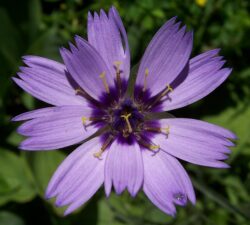In this article, we will discuss how to grow the perennial Catananche in containers. Catananche is a genus of flowering plants that belongs to the Asteraceae family (the Aster Family), where 5 species are known to exist. The only species of Catananche that is grown in the UK is Catananche caerulea, whereas the other 4 are not readily seen. It has the common name of cupid’s dart and the leaves are grey-green in colour.

It is grown for its bright blue, white or white/blue cornflower-like blooms that appear from early to late summer. Each flower has silvery buds and is produced on wiry stems. The cornflower-like blooms have papery petals that are blunt and serrated at the end.
The biggest problem is that it looks sparse as it does not have much foliage on the stems. It is best, therefore, to plant in groups of 3 to 5 to give a better display. The plants have virtues not often seen in other perennials-it can take dry compost, the flowering season is long and the flowers make excellent cut flowers when dried and used for flower arranging displays.
The other problem is that the plant is short-lived, so it may be best to treat it as a short-term plant. Find out how to grow this perennial of Catananche in containers in this article.
GROWING CATANANCHE IN CONTAINERS
You can grow Catananche either from shop-bought plants or just as easily from seeds. The choice is up to you.
GROWING FROM SEED
You will need to sow for 6 to 8 weeks before the last expected frost date, which is in March for most areas of the UK.
First, fill a seed tray with a good quality seed sowing compost and water it well until it is moist. On top of this sow the seeds thinly at a distance of 10cm apart. Cover the seeds with a 3mm layer of sieved seed compost and gently press it down. Place a propagator lid on top of the seeds tray and place it on a warm windowsill. After 1 to 2 weeks the seeds should have started to germinate and then you can place them in bright, indirect sunlight and allow them to grow on.
Once they are large enough to handle, you can prick the, out and place them into a 7.5cm pot full of multipurpose compost. Allow to grow on and in Mid-May start hardening off before planting in containers in late May.
At this stage, you can plant shop-bought plants and home-reared seedlings in exactly the same way.

As you will be planting in groups, it is best to use a large container like a half-barrel to grow them. Make sure, as always it has plenty of drainage holes in them. To this, add a 1cm layer of gravel to aid drainage even further.
On top of this create a sandy growing media by mixing 80 by volume of multipurpose compost with 20% by volume of building sand. Add this to the container until it reaches 5cm below the rim. For a half-barrel, it is recommended that you grow 3 plants, more if you can find bigger containers.
Dig 3 holes in the compost, one for each plant, slightly bigger than the root ball it came in the original container.
Place the plants in, one for each hole, so that the top of the root ball is at the same level as the top surface of the compost. Backfill with the growing media, so that no gaps remain using more compost if necessary. Form the plants in and water well.
GROWING CONDITIONS
Place the container in a spot that gets full sun, otherwise, it will not do well. You will need to water until it is established but after that, it will take drought pretty well. It is recommended that you water when 5cm below the surface of the compost feels dry to the touch. As it thrives in sandy soils, it will not need fertilizing unless the plant is suffering from an obvious deficiency.

You may need to offer support for the stems to stop them from flopping all over the place. After it has finished flowering, you can cut the spent blooms off to encourage more flowers to produce. After flowering cut back in spring to allow the attractive seed heads to be in on show over winter.
It can self-seed everywhere which will not be much of a problem in containers or if you cut the spent flowers before the seeds are produced.
PESTS AND DISEASES
It is an easy-to-grow plant and does not suffer from pests but it may suffer from powdery mildew. It is best avoided rather than treat by having good air circulation around the plant and by preventing the compost from drying too much.
VARIETIES TO GROW
The main species you will find and some will say the only species is Catananche caerulea.
The one to grow for large blue flowers is ‘Major’ or ‘Amor Blue’, whilst’ Alba’ produces white blooms instead. You can grow ‘Bicolour’ for a mix of the two colours.
CONCLUSIONS
In this article, we have discussed how to grow the short-lived but beautiful perennial of Catananche in containers. They not only produce colourful flowers that can be used in flower arranging but are easy to care for and look after. They also do not suffer from pests and diseases, so why not grow some today.
If you have any questions or comments about growing Catananche in containers, please do so in the comment box below.
Happy Catananche growing.
